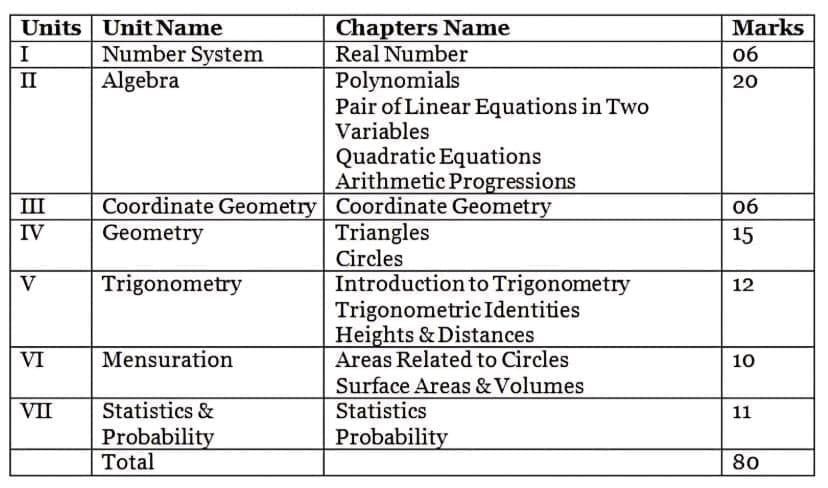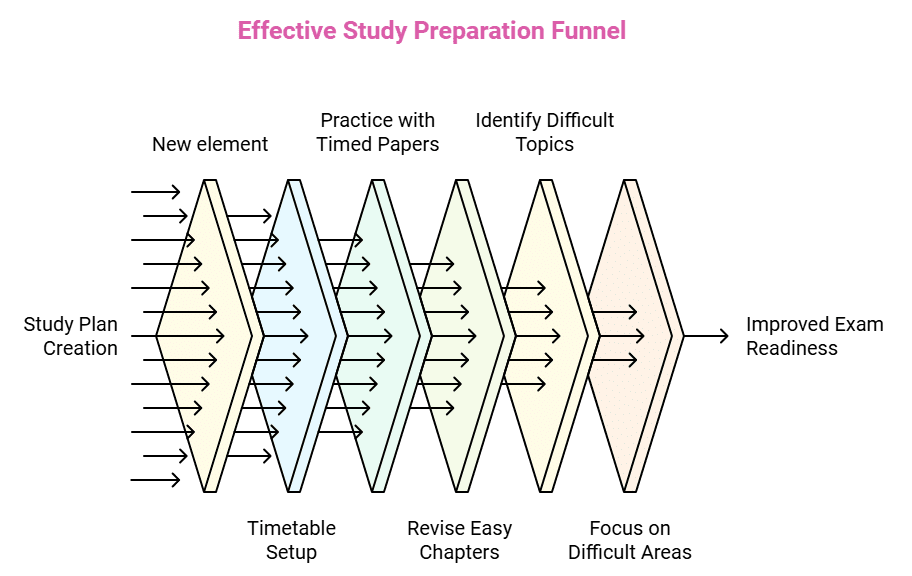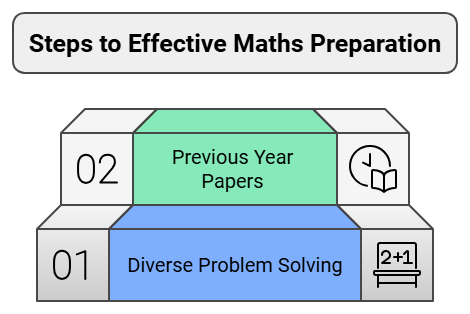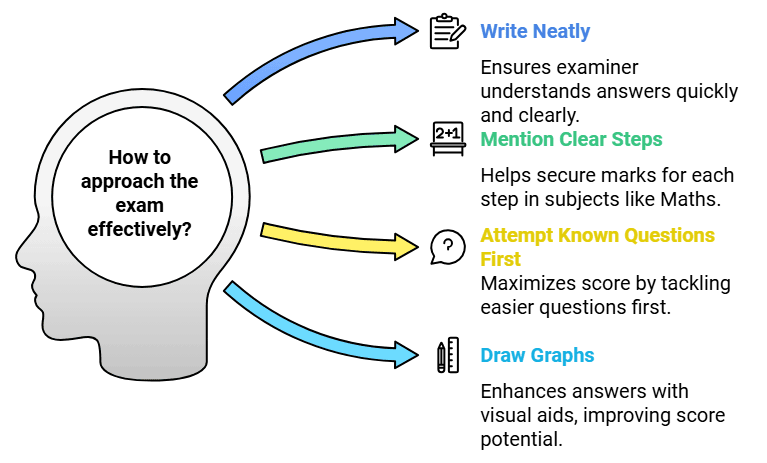How to prepare for Class 10 Mathematics (Math) : Tips & Tricks for Mathematics | How To Prepare For Class 10 PDF Download
The Maths for Class 10th under the CBSE board system is a very important subject and a fairly easy one from the point of view of scoring. The subject also requires more time to prepare as compared to the others. Maths is a very important subject because it will help you secure a high percentage in the board exams. In Maths, doing well is easy because as you solve everything correctly step by step, you can get full marks.

Mathematics Class 10 - Videos, Docs, MCQs
Includes 118 docs, 156 videos & 78 tests
Syllabus: Mathematics for Class 10 (CBSE)
The Class 10 Maths syllabus is divided into seven key units, covering essential topics —each contributing to a total of 80 marks in the board exam.
Here’s the topic-wise marks distribution and weightage of CBSE Class 10 Maths:

To explore the detailed syllabus and curriculum structure, you can access the comprehensive outline directly on EduRev:
Syllabus: Mathematics for Class 10 (CBSE) – EduRev
Preparation Tips for Maths Class 10:
1. Start with the Strong Basics:
Building a strong foundation is crucial when it comes to Mathematics. In Class 10, most problems become easy to solve only when the underlying concepts are clearly understood. That’s why focusing on the basics is the first step to scoring well in the exam.
Watch These Expert Videos to Get Started:
- Video: Tips to Score Good Marks in Maths
- Video: Tips to Study Maths for Class 10
- Video: Tips and Tricks to Attempt Your Exam Paper
2. NCERT is the Key
The NCERT book is not just essential—it’s the backbone of your Maths preparation. Practicing with NCERT solutions will help you:
Chaper 1 - Real Numbers
- NCERT Textbook: Real Numbers
- NCERT Solutions: Real Numbers (Exercise 1.1)
- NCERT Solutions: Real Numbers (Exercise 1.2)
Chapter 2 - Polynomials
Chapter 3 - Pair of Linear Equation in Two Variables
- NCERT Textbook: Pair of Linear Equations in Two Variables
- NCERT Solutions: Pair of Linear Equations in Two Variables (Exercise 3.1-3.3)
Chapter 4 - Quadratic Equations
Chapter 5 - Arithmetic Equations
- NCERT Textbook: Arithmetic Progressions
- NCERT Solutions: Arithmetic Progressions (Exercise 5.1 & 5.2)
- NCERT Solutions: Arithmetic Progressions (Exercise 5.3 & 5.4)
Chapter 6 - Triangles
Chapter 7 - Coordinate Geometry
- NCERT Textbook: Coordinate Geometry
- NCERT Solutions: Coordinate Geometry (Exercise 7.1)
- NCERT Solutions: Coordinate Geometry (Exercise 7.2)
Chapter 8 - Introduction to Trigonometry
Chapter 9 - Some Application of Trigonometry
- NCERT Textbook: Some Applications in Trigonometry
- NCERT Solutions: Some Applications of Trigonometry (Exercise 9.1)
Chapter 10 - Circles
Chapter 11 - Areas Related to Circles
Chapter 12 - Surface Area and Volumes
- NCERT Textbook: Surface Areas & Volumes
- NCERT Solutions: Surface Areas & Volumes (Exercises 12.1, 12.2)
Chapter 13 - Statistics
Chapter 14 - Probability
2. Follow a Smart Timetable
A well-planned timetable is the backbone of effective preparation—it turns goals into action and chaos into clarity. That’s why EduRev’s expertly designed chapter-wise and 60-day full-course timetables are game-changers for focused and efficient study. These timetables keep you motivated, structured, and on track every step of the way.
Practice sample papers with a timer to sharpen your speed, revise regularly, and start with easy chapters to build confidence early on. As you progress, mark tricky topics and give them extra attention. With EduRev’s smart timetables guiding your preparation, you won’t just study—you’ll study to succeed.

- Doc: 4 Days Timetable: Real Numbers
- Doc: 4 Days Timetable: Polynomials
- Doc: 4 Days Timetable: Pair of Linear Equations in Two Variables
- Doc: 4 Days Timetable: Quadratic Equations
- Doc: 4 Days Timetable: Arithmetic Progressions
- Doc: 4 Days Timetable: Triangles
- Doc: 4 Days Timetable: Coordinate Geometry
- Doc: 4 Days Timetable: Introduction to Trigonometry
- Doc: 4 Days Timetable: Some Applications of Trigonometry
- Doc: 4 Days Timetable: Circles
- Doc: 4 Days Timetable: Areas Related to Circles
- Doc: 4 Days Timetable: Surface Areas and Volumes
- Doc: 4 Days Timetable: Statistics
- Doc: 4 Days Timetable: Probability
- Doc: 60 Days Timetable for Mathematics Class 10
3. Solve Previous Year Questions (PYQs)
One of the smartest ways to prepare for the Class 10 Maths board exam is by solving Previous Year Questions (PYQs). They help you understand the exam pattern, frequently asked concepts, and the level of difficulty. To make your preparation smoother, here’s a chapter-wise list of PYQ resources available on EduRev. These links take you straight to high-quality, exam-focused questions for each chapter:

With the help of previous year papers, you will easily understand the level of questions which can be asked in CBSE Class 10th Maths board exam. Solving previous year papers will also enhance the writing speed of students.
Number Systems
Algebra
Geometry
Mensuration
Statistics & Probability
Tips and tricks to help you during the Exam:
1. Write Neatly:
You should keep in mind that the examiner has to understand every step of your answer and in most of the cases he would not be having much time to spend on a single answer. Avoid overwriting and write very neatly in your answer sheet.
2. Mention clear steps in your Answer:
Whenever you go through an answer, ensure to pay special attention to the steps that helped you to reach out to get the answer. You cannot simply write the answer and get full marks in Maths, you have to mention each and every step clearly. Instead of all this, learn the steps involved. You will definitely secure some marks for each step.
3. Attempt what you know first:
Read the question paper thoroughly before you begin to solve the questions. Mark the questions that you think will not take much time and attempt them first. In order to score high in Maths, you must attend the questions you know and then move on to the unfamiliar ones.
4. Draw Graphs
Using graphs and figures can help you to score more marks if you make them with concentration, accuracy and neatness. For this, you will need a ruler and a sharpened pencil. These are some of the simplest things that you should not forget to carry as they play a vital role in fetching marks.

Important Topics You Must Master
Chapter 1: Real Numbers
- Proof of irrationality
- Terminating and non-terminating decimals
- Tip: Focus on applications of HCF and LCM in real-world problems and proofs of irrationality.
Chapter 2: Polynomials
- Zeros of polynomial
- Relation between zeros and coefficients
- Tip: Practice finding zeros graphically and algebraically, and understand the factor theorem.
Chapter 3: Pair of Linear Equations in Two Variables
- Geometrically representing equations in two variables as lines
- Conditions of inconsistency of pair of linear equations
- Solving equations of two variables via different methods.
- Tip: Practice solving real-life problems (e.g., cost or age-based problems) using these methods.
Chapter 4: Quadratic Equations
- Solution of Quadratic Equations by Using Quadratic Formula
- Conditions under which a Quadratic Equation has Real or Imaginary Roots
- Tip: Practice solving real-life problems (e.g., cost or age-based problems) using these methods.
Chapter 5: Arithmetic Progressions
- nth Term of an Arithmetic Progression
- Sum of n Terms of an Arithmetic Progression
- Tip: Memorize and derive AP formulas; practice word problems involving sequences.
Chapter 6: Triangles
- Similarity of Triangles: Criteria (AA, SSS, SAS) and their proofs.
- Pythagoras Theorem: Statement, proof, and applications.
- Basic Proportionality Theorem (Thales’ Theorem): Proof and applications.
- Tip: Learn proofs thoroughly and practice diagram-based questions for similarity and Pythagoras theorem.
Chapter 7:Coordinate Geometry
- Distance Formula: Calculating distance between two points.
- Section Formula: For internal division (midpoint included).
- Tip: Practice problems involving collinearity and area calculations.
Chapter 8: Introduction to Trigonometry
- Trigonometric Ratios: Sine, cosine, tangent for acute angles.
- Standard Angle Values: Memorize trigonometric ratios for 0°, 30°, 45°, 60°, 90°.
- Trigonometric Identities: Proofs and applications (e.g., sin²θ + cos²θ = 1).
- Complementary Angles: Ratios and their relationships.
- Tip: Focus on identity proofs and solving problems using standard angle values.
Chapter 9: Some Applications of Trigonometry
- Heights and Distances: Solving problems involving angles of elevation and depression.
- Tip: Practice real-world problems with clear diagrams and trigonometric applications.
Chapter 10: Circles
- Tangents Drawn from an External Point to a Circle
- Proof and Application of Theorem 10.1 and 10.2
Chapter 11: Areas Related to Circles
- Area of a Circle and Its Segments: Sector, segment, and arc length calculations.
- Combinations of Plane Figures: Area problems involving circles and other shapes.
- Tip: Practice problems combining circles with triangles or rectangles.
Chapter 12: Surface Area & Volume
- Curved Surface Area of Combination of Solids
- Total Surface Area of Combination of Solids
- Volume of Combination of Solids
Chapter 13: Statistics
- Different methods for calculating mean or any missing frequency.
- Methods to find median and mode for a given data.
- Tip: Practice finding missing frequencies and interpreting ogives.
Chapter 14: Probability
- Theoretical Probability of Occurrence of Events
- Finding Probability Using Complement of a Known Event
- Tip: Focus on understanding the complement rule and solving basic probability questions.
Similarly, Prepare For Other Subjects Of Class 10:
- How to prepare for SST History for Class 10?
- How to prepare for SST Geography for Class 10?
- How to prepare for English for Class 10?
- How to prepare for SST Economics for Class 10?
- How to prepare for Science for Class 10?
- How to prepare for Hindi for Class 10?
- How to prepare for SST Civics for Class 10?
With the right strategy, consistent practice, and support from EduRev’s quality resources, scoring 90+ in Class 10 Maths is absolutely achievable. Start early, stay organized, and solve with understanding.
Prepare for Other Class 10 Subjects with Edurev
Social Science (SST) Class 10 (Videos | Docs | MCQs)
Science Class 10 - Videos, Docs, MCQs
English for Class 10 (Videos | Docs)
English Communicative (Interact In English) For Class 10
Hindi for Class 10 (Videos | Docs)
Information & Computer Technology (Class 10) - Notes & Video
Olympiad Preparation for Class 10
Crash Course for Class 10 Maths by Let's tute
|
8 videos|16 docs
|
FAQs on How to prepare for Class 10 Mathematics (Math) : Tips & Tricks for Mathematics - How To Prepare For Class 10
| 1. What are the key topics covered in Class 10 Maths NCERT textbooks? |  |
| 2. How can I effectively use NCERT solutions for Class 10 Maths preparation? |  |
| 3. What is the unit-wise weightage for Class 10 Maths exams? |  |
| 4. How can practice tests help in preparing for Class 10 Maths exams? |  |
| 5. What are some effective tips for studying Mathematics for Class 10? |  |

















